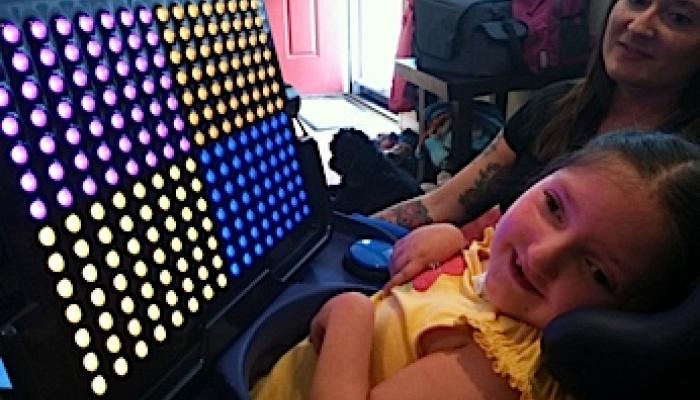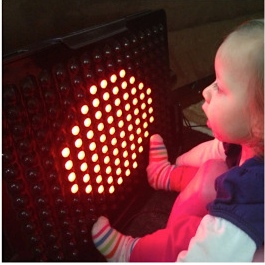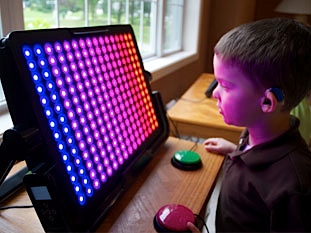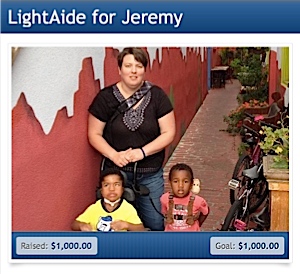Funding Opportunities for the LightAide

You’ve probably heard this before: “If there’s anything I can do, just let me know. I’d really like to help!”
A kind neighbor or acquaintance. Not someone who knows your child really well, but they seem eager to reach out. And most likely you smiled and went on with your day. What can they do to help? Your child has complex needs so they can’t take your kid for an hour while you nap (which is what you really want) and it’s probably a bit odd to ask that they come over and clean your house for you (which is a pretty close second on your list).
Here’s the thing though… People really do want to help! They just don’t know how. And there really are a lot of things that you need for your child, things that would make your life easier or make it easier for them to develop and learn, that may be too expensive for you to just go out and buy.
See where I’m going with this?
From established foundations, organizations and grants to friends, family and support networks, there are people out there who want to help you help your child!
The LightAide™
The first step is to figure out what you need and why. And from what we’re seeing through social media and email, a lot of you want a LightAide!
The LightAide is a portable assistive device that displays 224 bright and multi-colored LED lights. These lights can form shapes, letters or numbers… or dance across the screen, encouraging your child to track or reach out and touch the moving colors. It’s also compatible with a switch, so your child can learn to control and respond to the images on the screen or play games with up to four players!
Because it’s so diverse, the LightAide can support the core learning goals for children with a range of disabilities while developing the building blocks of literacy and mathematical concepts in learners with low vision, cognitive disabilities and other special needs.
Want to see the LightAide in action?
So you want one right? With a price tag of $999, you may need some help!
Grant Opportunities
 Grant applications can look challenging, but in the end they can provide necessary funds for helping your child learn and grow. Some grants have specific rules, so be sure to read the directions carefully. Often the grant application requires this additional information:
Grant applications can look challenging, but in the end they can provide necessary funds for helping your child learn and grow. Some grants have specific rules, so be sure to read the directions carefully. Often the grant application requires this additional information:
- Info about Your Family: List everyone who lives in your house and give a little information about your family’s background.
- Explain Your Child’s Disabilities: Explain in real terms what your child’s diagnosis is and how it affects your child at home.
- Explain Your Child’s Services: List all the services your child receives in school, through outpatient or in your home.
- Other Funding Resources: List all of the organizations that you have contacted or that you plan to contact.
For more items to consider including in your application, refer to this article on Funding Assistive Technology. Keep in mind that many organizations prefer to purchase the item on your behalf, so confirm your funding sources before buying your LightAide!
Funds Available for Assistive Technology
These groups have grants designed specifically to benefit disabled people who need assistive devices:
- The Association of Blind Citizens operates the Assistive Technology Fund. The Assistive Technology Fund (ATF) will provide funds to cover 50% of the retail price of adaptive devices or software. They do include income limits and diagnosis limits.
- The Disabled Children’s Relief Fund (DCRF) grant applications may be used for modest awards for assistive devices, rehabilitative services or arts and humanities projects.
Here are other groups that can potentially support assistive equipment or other needs for your child:
- Gracie’s Hope
- Hanna’s Helping Hands
- The Lindsay Foundation
- Maggie Welby Foundation
- Autism Care & Treatment
State-Specific Resources
 Some states have agencies that provide grants for people with developmental disabilities who have a highly urgent need for services. Here are some examples of specific state resources, so you’ll want to hunt for similar ones in your area (try searches for things like “special needs grants” and your state’s name):
Some states have agencies that provide grants for people with developmental disabilities who have a highly urgent need for services. Here are some examples of specific state resources, so you’ll want to hunt for similar ones in your area (try searches for things like “special needs grants” and your state’s name):
- The Autism Puzzle Foundation may be able to help you purchase equipment or services your child needs including (but not limited to) the following items: Specialized therapy, therapy swings & exercise balls, facilitated communication (FC) equipment, other augmentative and alternative communication (AAC), devices and boards and toys that help with sensory integration, fine motor skills, gross motor skills, tactile skills and cognition skills.
- United Cerebral Palsy of Central Maryland, Inc. provides grants (average $300) to individuals with Cerebral Palsy and physical disabilities. Call 410-574-7696 ext. 217 directly for an application.
- Zanes Foundation: Northeast Ohio
For more extensive lists previously discussed on WonderBaby.org, see 5 Ways to Get a Free iPad for Your Special Needs Child and Fundraising: Who to Contact.
Crowd-Sourcing Opportunities
 A LightAide can also be funded through online campaigns relatively easily. Check out Maria Lindquist’s successful GoFundMe campaign: LightAide for Jeremy.
A LightAide can also be funded through online campaigns relatively easily. Check out Maria Lindquist’s successful GoFundMe campaign: LightAide for Jeremy.
Nineteen friends and family raised the funds in two months! She only needed to write a brief paragraph about her child’s need and share her campaign on Facebook. And she even asked folks to forgo purchasing separate Christmas gifts and instead to make a contribution so they could provide the LightAide for her son for Christmas!
Hopefully this information helps you get motivated and tap into all the help just waiting for you! Here are some additional resources to get you on your way:
- A printable document explaining what the LightAide can do along with links to information about benefits and research that you can include with your grant requests: LightAide Funding Request Material
- If you need other ideas about how to use the LightAide with your child, check out the Backpacking LightAide Program where families write about how the LightAide was able to help their children.
- If you have questions, please email perkinsproducts@perkins.org.
Related Posts

Eye Conditions and Syndromes, Visual Impairment
Neuralink Announces Plans to Restore Sight to the Blind with Brain Chip
Elon Musk’s company Neuralink has announced plans to begin human trials of its new “Blindsight” brain chip by the end of 2025.

Special Needs
5 Spring Cleaning Tips for Families of Children with Disabilities
Spring cleaning is an opportunity to create a more accessible, organized, and supportive space for your child with disabilities. Declutter, deep clean, and refresh!

Visual Impairment
The Gift of Understanding: How a Young Child Helps His Blind Father Navigate Life
When a parent is blind, it’s natural for people to wonder how their sighted child will adapt. Will they struggle to understand their parent’s needs? Will they feel burdened by...